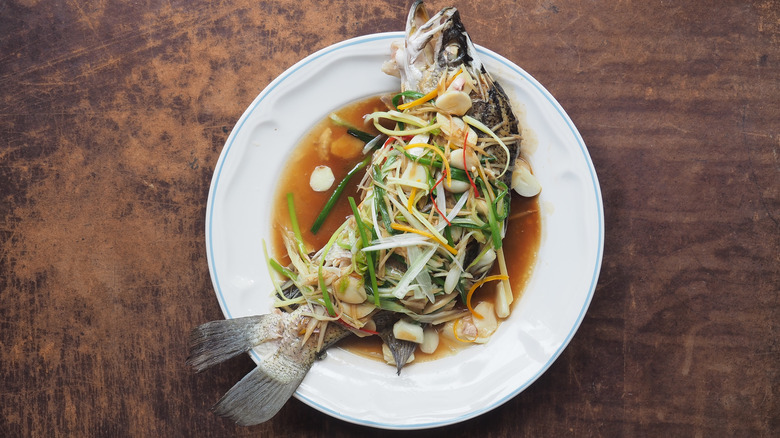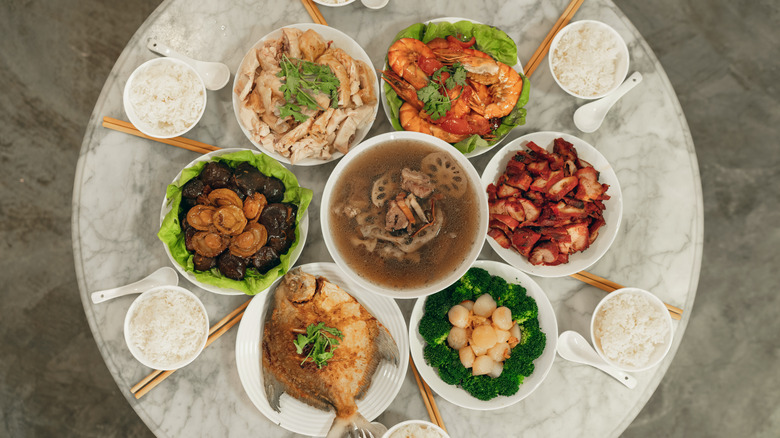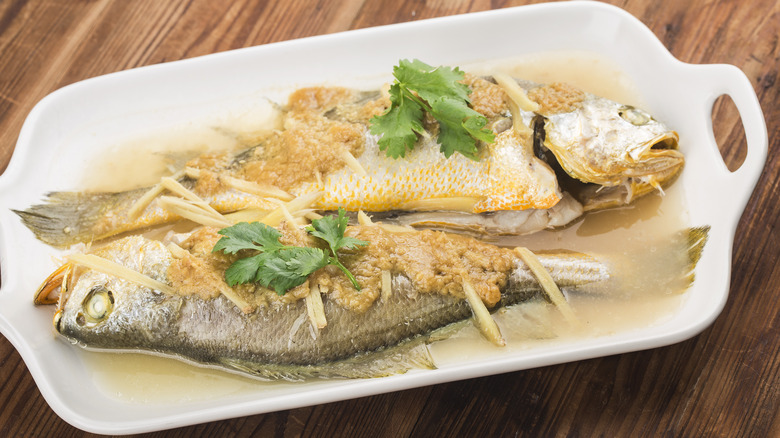Why It's Bad Etiquette To Flip Over A Whole Fish In China
Chinese culture places a great emphasis on food. Table manners and general politeness are important, but there are also many ingredients, dishes, and methods of eating that hold symbolic significance for Chinese people. Some of these underlying meanings are based on how the Chinese word for that food sounds, holiday traditions, inauspicious symbols, stories associated with the dish, or matters of hierarchy and respect. The symbolism behind the food and dining experience adds another layer of enjoyment and understanding to a dish, but also increases the likelihood that those who are not familiar with the customs may accidentally do something impolite.
Knowing how to eat a whole fish in China is an important example, especially because whole fish is often served for special occasions and holidays. In many cultures, it is normal to eat the meat from one side of the fish and then flip it over to get easy access to the meat from the other side. This is bad etiquette in a Chinese home or restaurant because it is said to bring bad luck. Flipping the fish symbolizes a fishing boat being flipped over — detrimental for anyone in the coastal fishing communities where this tradition originates.
Avoid culinary faux-pas when sharing a meal
When sitting down for a meal, never sit in the seat facing the door unless explicitly invited to do so. This is traditionally where the elder of the group or the host sits. Chinese food is usually eaten communally, and many dishes to share will be spread across a table or placed on a large lazy Susan in the center. Typically, you will have a set of chopsticks for serving from shared plates and another for eating off your own. If you have to set your chopsticks down, don't stick them straight up into a bowl of rice or noodles because they look like sticks of funeral incense. Instead, place them neatly side-by-side on the edge of your dish. Additionally, rubbing them against each other is a chopstick etiquette mistake that might insult your host.
If a whole fish is served, the head is positioned facing an honored guest or the elder of the table. That person should take the first bite, and then everyone else is free to dig in. Make sure no one is serving themselves, and then turn the wheel clockwise toward you. Use serving utensils to pull the flesh off the fish from one side. Once all the meat is gone from that side, you can remove the backbone and ribs, and place them to the side of the plate. Now you can access the other side — no flipping required!
How whole fish is often served
Often whole fish is served gently steamed and topped with a light and aromatic sauce with ginger, scallions, cilantro, and soy sauce. Some other versions might include Shaoxing wine, a bit of sugar, sesame oil, rice vinegar, or red chilies. Sichuan-style whole fish may be pan-cooked along with a fermented chili, soybean, and broad bean paste called doubanjiang and a type of fermented black bean called douchi.
No matter the recipe, serving a whole fish rather than pieces or filets also symbolizes prosperity and harmony. You shouldn't pick apart the head and the tail so as not to break up the good fortune that the whole fish brings, but the eyes and cheeks are fair game and considered a treat. If you happen to be enjoying a whole fish when the Lunar New Year is celebrated, there is another tradition to follow. In Chinese, the word for "fish" sounds similar to the word for "surplus." When you leave a little bit of meat on the bones, you are ushering in surplus for the year to come.



